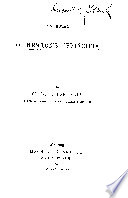 | Walter William Rouse Ball - 1893 - 195 lapas
...entrance into ye inverse method of fluxions. And the same year I began to think of gravity extending to ye orb of the Moon, and having found out how to estimate the force^ withjwch_[ajjglo^ sphere presses_the surf ace gfjbhe, spKe~re7from Kepler's Rule of the periodical... | |
 | Florian Cajori - 1899 - 344 lapas
...Science, pp. 152-156. In 1664 he made some observations on halos.1 In 1666, " I began," he says, " to think of gravity extending to the orb of the moon, . . . and thereby compared the force requisite to keep the moon in her orb with the force of gravity at the surface... | |
 | Florian Cajori - 1899 - 342 lapas
...Vol. 54., 1893, p. 381. In 1664 he made some observations on halos.1 In 1666, " I began," he says, " to think of gravity extending to the orb of the moon, . . . and thereby compared the force requisite to keep the moon in her orb with the force of gravity at the surface... | |
 | Smithsonian Institution. Board of Regents - 1901 - 1060 lapas
...glorious folly!" Galileo died in KJ42, and in the same year Newton was born. When 24 years old he "began to think of gravity extending to the orb of the moon." and before the end of the century he had discovered and established the great law of universal gravitation.... | |
 | 1901 - 598 lapas
...folly!" Galileo died in 1642, and in the same year Newton was born. When twenty-four years old he "began to think of gravity extending to the orb of the moon," and 303 THE PROGRESS OF THE CENTURY before the end of the century he had discovered and established the... | |
 | Francis Sydney Marvin - 1913 - 318 lapas
...other important theories, ' first the binomial theorem, then the method of fluxions,' and then ' began to think of gravity extending to the orb of the moon,...presses the surface of the sphere, from Kepler's rule (the third law) I deduced that the forces which keep the planets in their orb must be reciprocally... | |
 | Walter Libby - 1917 - 342 lapas
...hesitated, on account of certain unsettled points, to publish his results. He writes: "I began (1666) to think of gravity extending to the orb of the moon, . . . and thereby compared the force requisite to keep the moon in her orb with the force of gravity at the surface... | |
 | William Thompson Sedgwick, Harry Walter Tyler - 1917 - 526 lapas
...and in May following I had entrance into the inverse method of Fluxions. And the same year I began to think of gravity extending to the orb of the Moon, and . . . from Kepler's Rule of the periodical tunes of the Planets being in a sesquialterate proportion... | |
 | 1920 - 434 lapas
...that time, inter alia, ' first the binomial ' theorem, then the method of fluxions,' and then ' began to think of gravity extending to the orb of the moon,...force with which a globe, revolving within a sphere, from Kepler's rule (»'.«., the third law), I deduced that the forces which keep the planets in their... | |
 | Robert Henry Murray - 1921 - 104 lapas
...at that time, inter alia, "first the binomial theorem, then the method of fluxions," and then "began to think of gravity extending to the orb of the moon,...force with which a globe, revolving within a sphere, from Kepler's rule (ie, the third law), I deduced that the forces which keep the planets in their orb... | |
| |